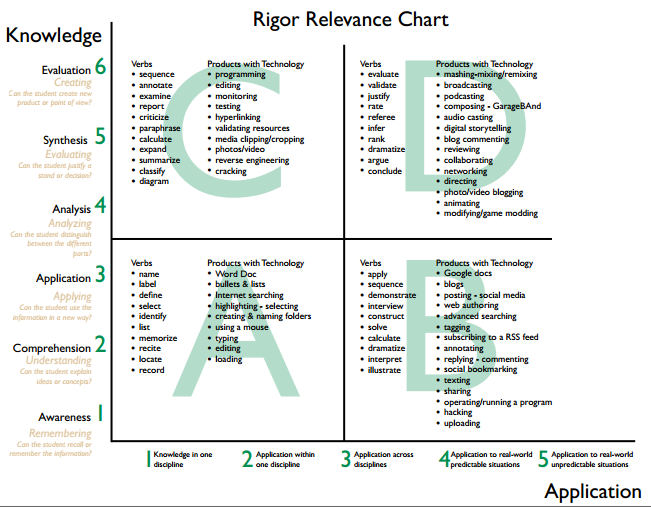A few weeks back I shared ways that digital tools can improve teaching and learning. It goes without saying that the most important aspect of digital leadership is enhancing student learning while increasing achievement. Technology needs to be integrated with purpose in ways that support learning as opposed to driving instruction. A good rule to follow is pedagogy first, technology second when appropriate. Using technology just for the sake of it is an ineffective practice. Effective digital leaders understand this and through the observation and evaluation of instruction ensure that digital tools align to learning outcomes and are having an impact on student learning.
Image credit: http://www.robeson.k12.nc.us/cms/lib6/NC01000307/Centricity/Domain/4057/Blooms_Circle.png
The main driver of successful, effective teaching originates from educators who are scaffolding learning in relevant and strong ways. A grounding in the Rigor/Relevance Framework -- an action-oriented continuum that describes putting knowledge to use -- gives teachers a method for charting learning. This framework is based on traditional elements of education yet encourages movement from acquisition of knowledge to application of knowledge. Although digital tools themselves are no substitute for a clear framework, they can underpin it. No matter what digital tool is considered, introduced, or integrated into the classroom, capable teacher presence and teacher-centered instruction always belongs in the foreground.
How can you, as a school leader, take your understanding of the strengths behind some digital tools and create pathways for rigorous and relevant use of digital tools? Use the following best practices when assessing digital tools and their use in your school:
Prioritize Instructional Excellence: Technology can be an effective tool but it remains just that -- a tool. Educators provide the backbone of the student’s learning experience. A teacher should always have concrete answers to these questions:
- What capabilities do I want my students to develop? In what specific ways is my instructional design rigorous and relevant?
- What are my benchmarks for rigor? relevance? relationships? creativity? inquiry?
- How does this digital tool provide a way towards full development of the capability I want to develop in my students?
- Is my teaching, using this tool, still just as structured, rigorous, and relevant as it would be without this tool?
Create a Game Plan for Managing Student Use of Online Tools: It takes work and careful planning to implement the use of digital tools in defined ways. Before introducing a digital tool into a learning context, teachers should understand:
- How he/she will be able to support students in using a tool that might be unfamiliar
- How each student will be able to manage it independently
- How he/she will take advantage of students’ diversity and inclination towards building community online
- How students and instructor will connect across sometimes great distance
- How will this online tool allow me to hone in on each student’s thought process and provide targeted, formative feedback that can be immediately and usefully applied?
- How can my feedback help pave the way for next steps in learning and in reaching established, articulated, or modeled goals?

Would love to do this with my faculty as a PD activity where they rate the apps/websites/digital activities that they use on the wheel and then compare it with this one. Could then do a follow up with the Rigor/Relevance chart!
ReplyDeleteSounds like a great idea Chris!
ReplyDeleteThis is a lead and learn session unto itself! Thanks for the awesome reference points.
ReplyDeleteThis comment has been removed by the author.
ReplyDelete